[English] 日本語
 Yorodumi
Yorodumi- PDB-1n5o: Structural consequences of a cancer-causing BRCA1-BRCT missense m... -
+ Open data
Open data
- Basic information
Basic information
| Entry | Database: PDB / ID: 1n5o | ||||||
|---|---|---|---|---|---|---|---|
| Title | Structural consequences of a cancer-causing BRCA1-BRCT missense mutation | ||||||
 Components Components | Breast cancer type 1 susceptibility protein | ||||||
 Keywords Keywords | ANTITUMOR PROTEIN / BRCA1 / BRCT / missense mutation / protein folding / Breast Cancer | ||||||
| Function / homology |  Function and homology information Function and homology informationhistone H2AK127 ubiquitin ligase activity / histone H2AK129 ubiquitin ligase activity / Defective DNA double strand break response due to BRCA1 loss of function / Defective DNA double strand break response due to BARD1 loss of function / BRCA1-BARD1 complex / BRCA1-B complex / BRCA1-A complex / BRCA1-C complex / negative regulation of centriole replication / sex-chromosome dosage compensation ...histone H2AK127 ubiquitin ligase activity / histone H2AK129 ubiquitin ligase activity / Defective DNA double strand break response due to BRCA1 loss of function / Defective DNA double strand break response due to BARD1 loss of function / BRCA1-BARD1 complex / BRCA1-B complex / BRCA1-A complex / BRCA1-C complex / negative regulation of centriole replication / sex-chromosome dosage compensation / random inactivation of X chromosome / ubiquitin-modified histone reader activity / chordate embryonic development / cellular response to indole-3-methanol / gamma-tubulin ring complex / negative regulation of intracellular estrogen receptor signaling pathway / nuclear ubiquitin ligase complex / DNA strand resection involved in replication fork processing / homologous recombination / negative regulation of fatty acid biosynthetic process / Regulation of MITF-M-dependent genes involved in DNA replication, damage repair and senescence / protein K6-linked ubiquitination / lateral element / regulation of DNA damage checkpoint / Impaired BRCA2 binding to PALB2 / XY body / mitotic G2/M transition checkpoint / RNA polymerase binding / DNA repair complex / DNA damage tolerance / centrosome cycle / Homologous DNA Pairing and Strand Exchange / Defective homologous recombination repair (HRR) due to BRCA1 loss of function / Defective HDR through Homologous Recombination Repair (HRR) due to PALB2 loss of BRCA1 binding function / Defective HDR through Homologous Recombination Repair (HRR) due to PALB2 loss of BRCA2/RAD51/RAD51C binding function / Resolution of D-loop Structures through Synthesis-Dependent Strand Annealing (SDSA) / intracellular membraneless organelle / Resolution of D-loop Structures through Holliday Junction Intermediates / HDR through Single Strand Annealing (SSA) / response to ionizing radiation / negative regulation of gene expression via chromosomal CpG island methylation / Impaired BRCA2 binding to RAD51 / Transcriptional Regulation by E2F6 / mitotic G2 DNA damage checkpoint signaling / negative regulation of cell cycle / negative regulation of reactive oxygen species metabolic process / Presynaptic phase of homologous DNA pairing and strand exchange / positive regulation of vascular endothelial growth factor production / ubiquitin ligase complex / SUMOylation of DNA damage response and repair proteins / regulation of DNA repair / negative regulation of extrinsic apoptotic signaling pathway via death domain receptors / protein autoubiquitination / tubulin binding / Meiotic synapsis / positive regulation of DNA repair / cellular response to ionizing radiation / male germ cell nucleus / chromosome segregation / TP53 Regulates Transcription of DNA Repair Genes / Nonhomologous End-Joining (NHEJ) / negative regulation of cell growth / double-strand break repair via homologous recombination / G2/M DNA damage checkpoint / RING-type E3 ubiquitin transferase / HDR through Homologous Recombination (HRR) / Meiotic recombination / Metalloprotease DUBs / intrinsic apoptotic signaling pathway in response to DNA damage / positive regulation of angiogenesis / ubiquitin-protein transferase activity / fatty acid biosynthetic process / p53 binding / cellular response to tumor necrosis factor / KEAP1-NFE2L2 pathway / double-strand break repair / Recruitment and ATM-mediated phosphorylation of repair and signaling proteins at DNA double strand breaks / chromosome / Neddylation / Processing of DNA double-strand break ends / Regulation of TP53 Activity through Phosphorylation / damaged DNA binding / transcription coactivator activity / transcription cis-regulatory region binding / regulation of cell cycle / nuclear body / protein ubiquitination / chromatin remodeling / ribonucleoprotein complex / DNA repair / negative regulation of DNA-templated transcription / DNA damage response / ubiquitin protein ligase binding / positive regulation of gene expression / regulation of transcription by RNA polymerase II / positive regulation of DNA-templated transcription / enzyme binding / positive regulation of transcription by RNA polymerase II / protein-containing complex / DNA binding Similarity search - Function | ||||||
| Biological species |  Homo sapiens (human) Homo sapiens (human) | ||||||
| Method |  X-RAY DIFFRACTION / X-RAY DIFFRACTION /  SYNCHROTRON / SYNCHROTRON /  MOLECULAR REPLACEMENT / Resolution: 2.8 Å MOLECULAR REPLACEMENT / Resolution: 2.8 Å | ||||||
 Authors Authors | Williams, R.S. / Glover, J.N.M. | ||||||
 Citation Citation |  Journal: J.Biol.Chem. / Year: 2003 Journal: J.Biol.Chem. / Year: 2003Title: Structural consequences of a cancer-causing BRCA1-BRCT missense mutation Authors: Williams, R.S. / Glover, J.N.M. | ||||||
| History |
|
- Structure visualization
Structure visualization
| Structure viewer | Molecule:  Molmil Molmil Jmol/JSmol Jmol/JSmol |
|---|
- Downloads & links
Downloads & links
- Download
Download
| PDBx/mmCIF format |  1n5o.cif.gz 1n5o.cif.gz | 54.4 KB | Display |  PDBx/mmCIF format PDBx/mmCIF format |
|---|---|---|---|---|
| PDB format |  pdb1n5o.ent.gz pdb1n5o.ent.gz | 38.2 KB | Display |  PDB format PDB format |
| PDBx/mmJSON format |  1n5o.json.gz 1n5o.json.gz | Tree view |  PDBx/mmJSON format PDBx/mmJSON format | |
| Others |  Other downloads Other downloads |
-Validation report
| Summary document |  1n5o_validation.pdf.gz 1n5o_validation.pdf.gz | 438.9 KB | Display |  wwPDB validaton report wwPDB validaton report |
|---|---|---|---|---|
| Full document |  1n5o_full_validation.pdf.gz 1n5o_full_validation.pdf.gz | 442.1 KB | Display | |
| Data in XML |  1n5o_validation.xml.gz 1n5o_validation.xml.gz | 10.4 KB | Display | |
| Data in CIF |  1n5o_validation.cif.gz 1n5o_validation.cif.gz | 13.7 KB | Display | |
| Arichive directory |  https://data.pdbj.org/pub/pdb/validation_reports/n5/1n5o https://data.pdbj.org/pub/pdb/validation_reports/n5/1n5o ftp://data.pdbj.org/pub/pdb/validation_reports/n5/1n5o ftp://data.pdbj.org/pub/pdb/validation_reports/n5/1n5o | HTTPS FTP |
-Related structure data
| Related structure data | 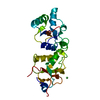 1jnxS S: Starting model for refinement |
|---|---|
| Similar structure data |
- Links
Links
- Assembly
Assembly
| Deposited unit | 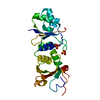
| ||||||||
|---|---|---|---|---|---|---|---|---|---|
| 1 |
| ||||||||
| Unit cell |
|
- Components
Components
| #1: Protein | Mass: 24557.232 Da / Num. of mol.: 1 / Fragment: BRCT (residues 1646-1859) / Mutation: M1775R Source method: isolated from a genetically manipulated source Source: (gene. exp.)  Homo sapiens (human) / Gene: BRCA1 / Production host: Homo sapiens (human) / Gene: BRCA1 / Production host:  | ||
|---|---|---|---|
| #2: Chemical | ChemComp-CO / | ||
| #3: Chemical | | #4: Water | ChemComp-HOH / | |
-Experimental details
-Experiment
| Experiment | Method:  X-RAY DIFFRACTION / Number of used crystals: 1 X-RAY DIFFRACTION / Number of used crystals: 1 |
|---|
- Sample preparation
Sample preparation
| Crystal | Density Matthews: 4.68 Å3/Da / Density % sol: 73.74 % | |||||||||||||||||||||||||||||||||||
|---|---|---|---|---|---|---|---|---|---|---|---|---|---|---|---|---|---|---|---|---|---|---|---|---|---|---|---|---|---|---|---|---|---|---|---|---|
| Crystal grow | Temperature: 293 K / Method: vapor diffusion, hanging drop / pH: 6.7 Details: ammonium sulphate, cobalt chloride, MES, pH 6.7, VAPOR DIFFUSION, HANGING DROP, temperature 293K | |||||||||||||||||||||||||||||||||||
| Crystal grow | *PLUS | |||||||||||||||||||||||||||||||||||
| Components of the solutions | *PLUS
|
-Data collection
| Diffraction | Mean temperature: 100 K |
|---|---|
| Diffraction source | Source:  SYNCHROTRON / Site: SYNCHROTRON / Site:  APS APS  / Beamline: 19-ID / Wavelength: 1.0093 Å / Beamline: 19-ID / Wavelength: 1.0093 Å |
| Detector | Type: SBC-2 / Detector: CCD / Date: Dec 8, 2001 |
| Radiation | Protocol: SINGLE WAVELENGTH / Monochromatic (M) / Laue (L): M / Scattering type: x-ray |
| Radiation wavelength | Wavelength: 1.0093 Å / Relative weight: 1 |
| Reflection | Resolution: 2.8→50 Å / Num. obs: 12024 / Observed criterion σ(I): 0 |
| Reflection | *PLUS Lowest resolution: 50 Å / % possible obs: 99.3 % / Num. measured all: 100697 / Rmerge(I) obs: 0.068 |
| Reflection shell | *PLUS % possible obs: 100 % / Rmerge(I) obs: 0.404 / Mean I/σ(I) obs: 3.3 |
- Processing
Processing
| Software |
| |||||||||||||||||||||||||||||||||||||||||||||||||||||||||||||||||||||||||||
|---|---|---|---|---|---|---|---|---|---|---|---|---|---|---|---|---|---|---|---|---|---|---|---|---|---|---|---|---|---|---|---|---|---|---|---|---|---|---|---|---|---|---|---|---|---|---|---|---|---|---|---|---|---|---|---|---|---|---|---|---|---|---|---|---|---|---|---|---|---|---|---|---|---|---|---|---|
| Refinement | Method to determine structure:  MOLECULAR REPLACEMENT MOLECULAR REPLACEMENTStarting model: pdb entry 1jnx Resolution: 2.8→20 Å / Cor.coef. Fo:Fc: 0.907 / Cor.coef. Fo:Fc free: 0.883 / TLS residual ADP flag: LIKELY RESIDUAL / Cross valid method: THROUGHOUT / σ(F): 0 / Stereochemistry target values: MAXIMUM LIKELIHOOD
| |||||||||||||||||||||||||||||||||||||||||||||||||||||||||||||||||||||||||||
| Solvent computation | Shrinkage radii: 0.8 Å / Solvent model: BABINET MODEL WITH MASK | |||||||||||||||||||||||||||||||||||||||||||||||||||||||||||||||||||||||||||
| Displacement parameters | Biso mean: 30.131 Å2
| |||||||||||||||||||||||||||||||||||||||||||||||||||||||||||||||||||||||||||
| Refinement step | Cycle: LAST / Resolution: 2.8→20 Å
| |||||||||||||||||||||||||||||||||||||||||||||||||||||||||||||||||||||||||||
| Refine LS restraints |
| |||||||||||||||||||||||||||||||||||||||||||||||||||||||||||||||||||||||||||
| LS refinement shell | Resolution: 2.802→2.874 Å / Total num. of bins used: 20 /
| |||||||||||||||||||||||||||||||||||||||||||||||||||||||||||||||||||||||||||
| Refinement TLS params. | Method: refined / Origin x: 24.4148 Å / Origin y: 58.579 Å / Origin z: 36.9806 Å
| |||||||||||||||||||||||||||||||||||||||||||||||||||||||||||||||||||||||||||
| Refinement TLS group |
| |||||||||||||||||||||||||||||||||||||||||||||||||||||||||||||||||||||||||||
| Refinement | *PLUS Highest resolution: 2.8 Å / Lowest resolution: 20 Å / % reflection Rfree: 7 % / Rfactor Rfree: 0.298 / Rfactor Rwork: 0.273 | |||||||||||||||||||||||||||||||||||||||||||||||||||||||||||||||||||||||||||
| Solvent computation | *PLUS | |||||||||||||||||||||||||||||||||||||||||||||||||||||||||||||||||||||||||||
| Displacement parameters | *PLUS | |||||||||||||||||||||||||||||||||||||||||||||||||||||||||||||||||||||||||||
| Refine LS restraints | *PLUS
|
 Movie
Movie Controller
Controller


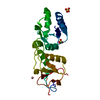

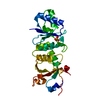
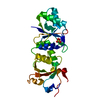
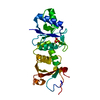
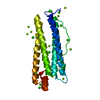
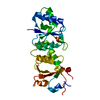
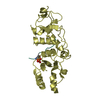
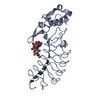
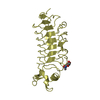


 PDBj
PDBj





















